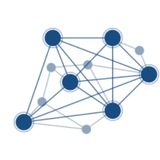📄Network data
💥This page contains links to some network data sets I've compiled over the years. All of these are free for scientific use to the best of my knowledge, meaning that the original authors have already made the data freely available, or that I have consulted the authors and received permission to the post the data here, or that the data are mine. If you make use of any of these data, please cite the original sources.
📎Most popular network datasets
📲Channel: @ComplexNetworkAnalysis
#dataset
💥This page contains links to some network data sets I've compiled over the years. All of these are free for scientific use to the best of my knowledge, meaning that the original authors have already made the data freely available, or that I have consulted the authors and received permission to the post the data here, or that the data are mine. If you make use of any of these data, please cite the original sources.
📎Most popular network datasets
📲Channel: @ComplexNetworkAnalysis
#dataset
👍1
📄Stanford Network Analysis Platform (SNAP)
💥Purpose:
SNAP is a general-purpose network analysis and graph mining library.
🔹Language: It is written in C++.
🔹Scalability: SNAP easily scales to handle massive networks with hundreds of millions of nodes and billions of edges.
💥Functionality:
Efficiently manipulates large graphs.
Calculates structural properties.
Generates regular and random graphs.
Supports attributes on nodes and edges.
🔹Python Interface: Snap.py provides a Python interface for SNAP, combining the performance benefits of SNAP with the flexibility of Python.
💥Stanford Large Network Dataset Collection:
This collection includes over 50 large network datasets:
🔹Social networks: Represent online social interactions between people.
🔹Networks with ground-truth communities: These are community structures in social and information networks.
🔹Communication networks: Email communication networks, where edges represent communication between individuals.
💥Tutorials and Recent Events:
SNAP hosts tutorials on topics such as deep learning for network biology, representation learning on networks, and more.
They have organized workshops and tutorials at conferences like ISMB, The Web Conference, and WWW.
🌐 Study
📲Channel: @ComplexNetworkAnalysis
#paper #Graph #code #Python #Tutorials #Dataset
💥Purpose:
SNAP is a general-purpose network analysis and graph mining library.
🔹Language: It is written in C++.
🔹Scalability: SNAP easily scales to handle massive networks with hundreds of millions of nodes and billions of edges.
💥Functionality:
Efficiently manipulates large graphs.
Calculates structural properties.
Generates regular and random graphs.
Supports attributes on nodes and edges.
🔹Python Interface: Snap.py provides a Python interface for SNAP, combining the performance benefits of SNAP with the flexibility of Python.
💥Stanford Large Network Dataset Collection:
This collection includes over 50 large network datasets:
🔹Social networks: Represent online social interactions between people.
🔹Networks with ground-truth communities: These are community structures in social and information networks.
🔹Communication networks: Email communication networks, where edges represent communication between individuals.
💥Tutorials and Recent Events:
SNAP hosts tutorials on topics such as deep learning for network biology, representation learning on networks, and more.
They have organized workshops and tutorials at conferences like ISMB, The Web Conference, and WWW.
🌐 Study
📲Channel: @ComplexNetworkAnalysis
#paper #Graph #code #Python #Tutorials #Dataset
🔥2👏2👍1
